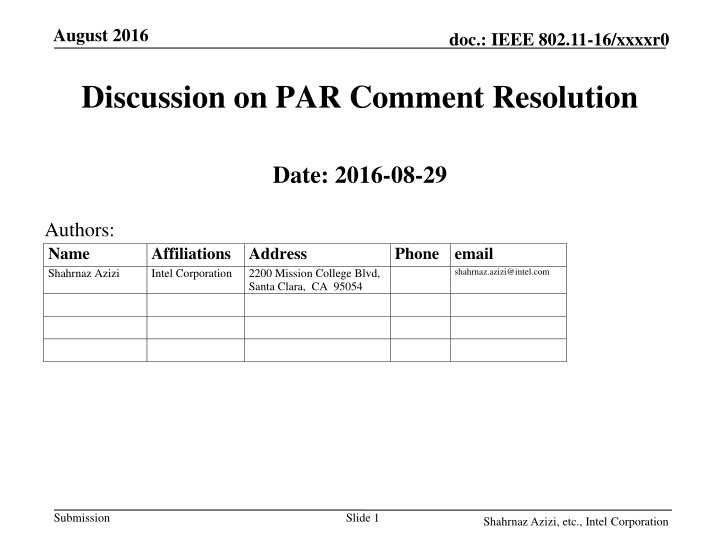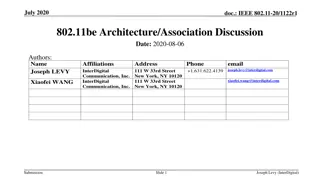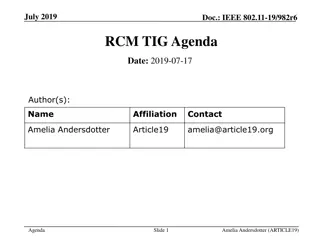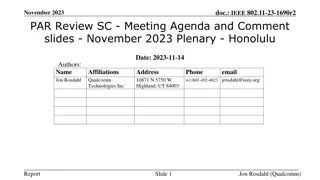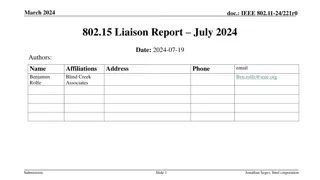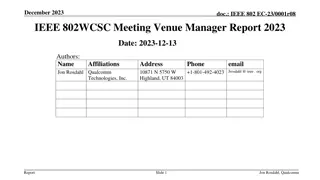IEEE 802.11-16/xxxxr0 August 2016 Discussion Summary
The document discusses comments and proposed resolutions regarding user data, different bands, operation, and latency in IEEE 802.11-16/xxxxr0. Various categories like wake-up packets, band definitions for 2.4 GHz and 5 GHz, radio transitions, and ongoing latency discussions are tackled in this August 2016 report by Shahrnaz Azizi from Intel Corporation.
Download Presentation

Please find below an Image/Link to download the presentation.
The content on the website is provided AS IS for your information and personal use only. It may not be sold, licensed, or shared on other websites without obtaining consent from the author.If you encounter any issues during the download, it is possible that the publisher has removed the file from their server.
You are allowed to download the files provided on this website for personal or commercial use, subject to the condition that they are used lawfully. All files are the property of their respective owners.
The content on the website is provided AS IS for your information and personal use only. It may not be sold, licensed, or shared on other websites without obtaining consent from the author.
E N D
Presentation Transcript
August 2016 doc.: IEEE 802.11-16/xxxxr0 Discussion on PAR Comment Resolution Date: 2016-08-29 Authors: Name Shahrnaz Azizi Affiliations Address Intel Corporation Phone email shahrnaz.azizi@intel.com 2200 Mission College Blvd, Santa Clara, CA 95054 Submission Slide 1 Shahrnaz Azizi, etc., Intel Corporation
August 2016 doc.: IEEE 802.11-16/xxxxr0 Overview of Comments Comments were categorized in five groups: 1. User data 2. Different bands 3. Operation 4. Latency 5. Miscellaneous Submission Slide 2 Shahrnaz Azizi, etc., Intel Corporation
August 2016 doc.: IEEE 802.11-16/xxxxr0 Category 1: User data Proposed resolution was to modify as follows: The wake-up packets carry only control information, and they do not carry any user payload data. Two sets of opinions: 1. Remove the user data part: The wake-up packets carry only (WUR ? ) control information, and they do not carry any user payload data. 2. Keep (only) the user data part: The wake-up packets carry only control information, and they do not carry any user payload data. Remedy: run a straw poll in SG to finalize Submission Slide 3 Shahrnaz Azizi, etc., Intel Corporation
August 2016 doc.: IEEE 802.11-16/xxxxr0 Category 2: Different bands Proposed resolution was to modify as follows: This amendment defines operations for 2.4 GHz and 5 GHz bands. The wake-up packet may be transmitted in the same band or in a different band other that the primary connectivity radio is using. Have consensus on this resolution. There was a question on whether Sub1GHz should be added, which was cleared after pointing that Sub1GHz is already mentioned in the explanatory section Submission Slide 4 Shahrnaz Azizi, etc., Intel Corporation
August 2016 doc.: IEEE 802.11-16/xxxxr0 Category 3: Operation Proposed resolution was to modify as follows: The reception of the wake-up packet by the WUR may triggers a transition of the primary connectivity radio (used for transfer of normal 802.11 packets) to come out of from sleep to normal operation. Have consensus on this resolution with the following grammar change The reception of the wake-up packet by the WUR may triggers a transition of the primary connectivity radio (used for transfer of normal 802.11 packets) out of from sleep to normal operation. Additional suggestion: change out of from sleep to to awake state Submission Slide 5 Shahrnaz Azizi, etc., Intel Corporation
August 2016 doc.: IEEE 802.11-16/xxxxr0 Category 4: Latency Proposed resolution was to modify as follows: Ongoing: discussions has initiated in an email thread among interested folks Submission Slide 6 Shahrnaz Azizi, etc., Intel Corporation
August 2016 doc.: IEEE 802.11-16/xxxxr0 Category 5: Miscellaneous Proposed resolution was to modify as follows: Ongoing: discussions has initiated in an email thread among interested folks Submission Slide 7 Shahrnaz Azizi, etc., Intel Corporation
August 2016 doc.: IEEE 802.11-16/xxxxr0 Straw Poll 1 Do you agree to remove the user data part in order to have the following text: The wake-up packets carry only control information. Yes No Abstain Submission Slide 8 Shahrnaz Azizi, etc., Intel Corporation
